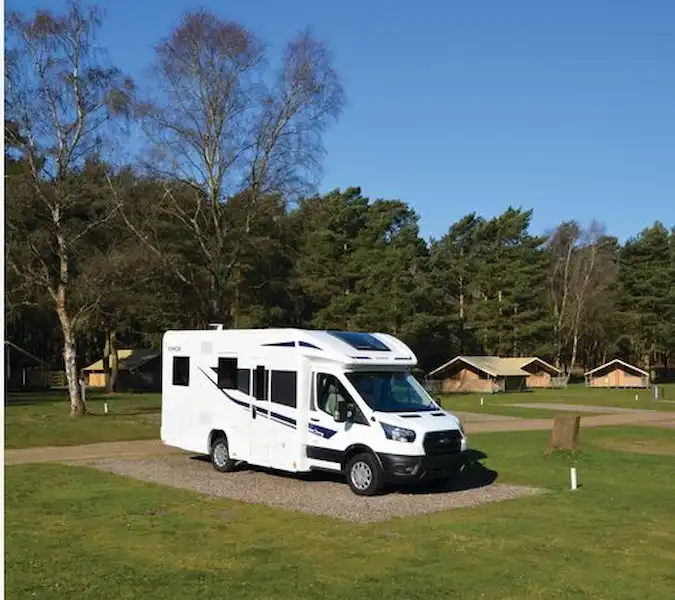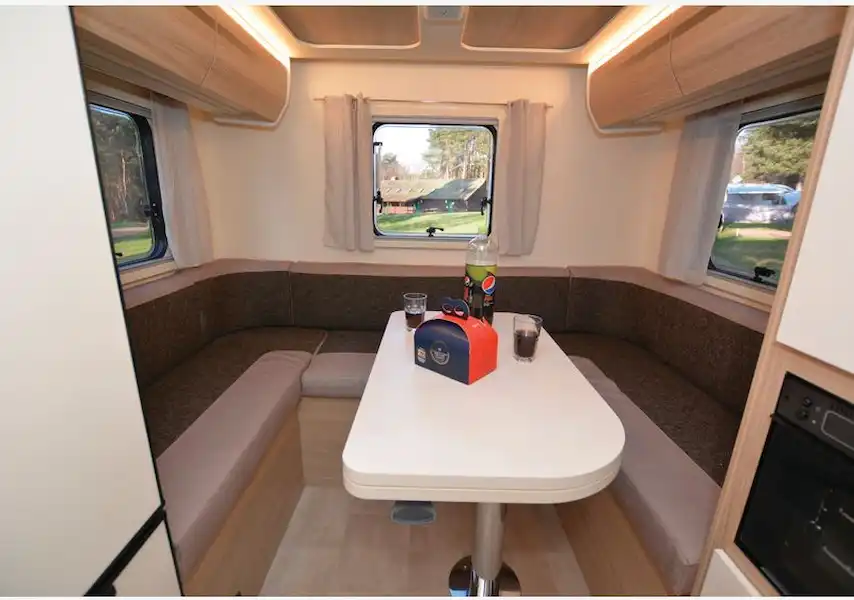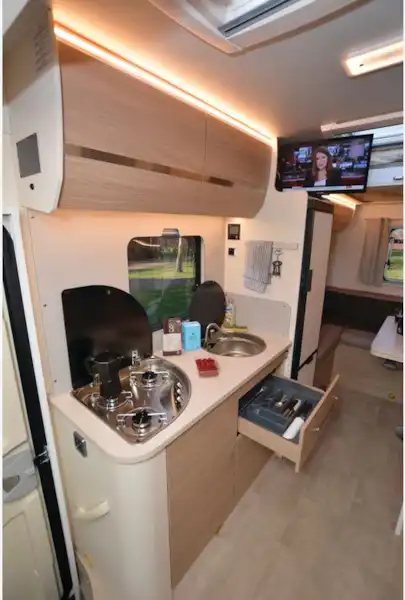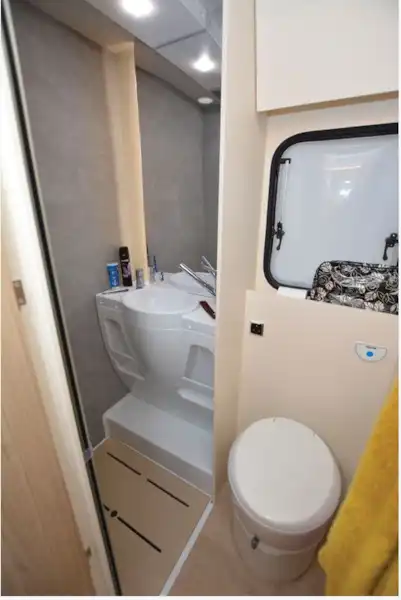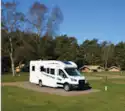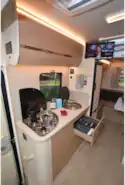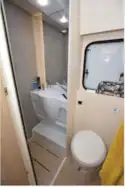Key Features
| Model Year | 2022 |
| Class | Low Profile Drop Down Bed |
| Base Vehicle | Ford Transit |
| Price From (£) | 56,495 |
| Engine Size | 2.0TD |
| Maximum Weight (kg) | 3,500 |
| Berths | 5 |
| Main Layout | Rear Lounge |
At a glance
Full review
Words and photos: Peter Vaughan
The Rimor Evo 77 Plus
When Italian motorhomes first landed in big numbers in the UK, in the late 90s, it was their price tags that caught our attention first. Buyers often had to live with some fairly bold upholstery choices, but that was a small price to pay when they cost so much less.
In more recent years, the brands from Tuscany have increased their attention on quality and their cost advantage has been eroded, but we might just have found a model that still gives its rivals a kicking in the pound notes department.
The Rimor Evo range includes two overcab models and four low-profiles, with prices from only £52,995. Not only that, but all Blighty-bound Evos come with the M and C Enhanced UK Pack (named after Rimor’s importer in Hull), which includes £4,200 worth of additional kit as standard.
Tested here is the model that has, perhaps, the widest appeal amongst British buyers, the 77 Plus, which fits front and rear lounges into a sub-7m overall length. It is priced at £56,495 and, in early March, there were still a few examples left at this 2022-season price. Miss those and there’s a £3k price rise, but you should still be able to drive away an identical 2023 model-year motorhome this autumn.
The cab
When you do get behind the wheel, you’ll appreciate the advantages of the Transit cab, with its more car-like driving position in which you sit lower than a Fiat/Peugeot with a reach and rake-adjustable steering wheel and height/tilt variation for the chairs. The leather-bound helm isn’t bus-sized, either, but it’s the performance of the 168bhp (170PS) engine that makes the strongest impression. That potent power unit is standard and it feels way more suitable for a motorhome than Fiat’s 140bhp motor. Mated to the optional automatic gearbox (which has fewer ratios but adds less to the price tag than the Ducato’s auto’ transmission), you’ll enjoy relaxed, effortless motoring.
The Ford also has quite contrasting on-road manners, thanks to its softer, more absorbent suspension. On the downside, there’s more lean when cornering and we suffered some buffeting across the windswept Fens, but the benefit is a much more comfortable ride. And, I suspect, the suspension was a contributory factor in the very pleasing absence of rattles and clatter from the living area (even though we were fully loaded for a weekend away).
As well as the engine upgrade, the standard spec here includes everything you could wish for, bar a fancy touchscreen and sat-nav.
Replacing the central mirror is a rear view camera that’s switched on all the time you’re on the road and, while this DAB radio might look basic, it offers Bluetooth and is linked to audio/phone switches on the steering wheel. There’s a cradle for a mobile, too.
Cruise control, cab air-con and a passenger airbag are all featured, as are a Category 1 alarm and tracker, so the only thing I could moan about was the very pale vinyl trim on the front seats and the fact it was already starting to wrinkle on the squabs.
On the outside
Externally, there’s nothing to indicate that this an entry-level motorhome, although you’ll need a key to open the habitation door; the remote central locking being for just
the cab doors. The entrance does have a flyscreen and window, however, and the tinted habitation windows don’t sit as proud of the body as some.
Alloy wheels are available as a £897 option, while the overcab sunroof, LED tail lights with swiping arrow indicators and TV aerial are standard.
Although the 77 Plus eschews the usual continental fixed bed formats, it still offers generous external storage with locker doors on either side giving access to space below the rear lounge.
Stretching the full width of the motorhome with a 650mm internal height and 200kg weight limit, it’s perfect for all your outdoor furniture, etc.
The waste water tank also impressed, with its 120-litre capacity and quick and easy draining. The fresh tank is inboard for winterisation and is a rather modest 85 litres.
The layout
Inside, the U-shaped rear lounge will be a key reason to buy the 77 Plus. It’s a comfortable space to relax, with just enough room to put your feet up on the sofas and, while it has the expected triple-aspect glazing, the windows aren’t huge, lending the area a more cosy, private feel. Net curtains can increase this further.
On test, we saw the rear as the lounge and the front seating as the dining area, but there’s a fixed table aft as well. Folded in half, this is unobtrusive and ideal for drinks, while expanded it is huge (0.92m by 1.06m) – fortunately this banquet-sized tabletop still twists and slides to let you get out of your seat.
Just as flexible – rotating, sliding and folding – but not as enormous (670mm by 950mm), the front table can cater for four diners but might be a stretch for five. Nevertheless, there’s plenty of seating here for a family, with both cab chairs swivelling, an L-settee on the nearside and a surprisingly comfortable inward-facing seat (complete with headrest) on the offside. Perhaps because of daylight flooding in through the overcab sunroof, this area feels more spacious than the rear lounge.
It’s also the better place to view the 18.5in Falcon TV (a £279 option), which is mounted high above the fridge. The telly can be turned to face front or rear but, actually, the best place to watch from is the rear bed.
Lighting is fairly generous throughout the Evo, with LED strips mounted above and below all the top lockers and additional small lamps in three places in the ceiling. There are no directional reading lights, however – their absence being most noticeable in the cab.
Where the 77 Plus does score is in being a genuine five-person motorhome, featuring a quintet of belts and berths. The half-dinette bench, of course, has the expected three-point belts, while the fifth travel seat is created by turning the side seat into a rear-facing pew. It just has a lap strap and small head restraint and it is reassuring to see the hefty steel structure beneath.
There’s a small amount of storage below this seat, too (although space is shared by the gas locker). Under the half-dinette is the fresh water tank, while the area under the rear lounge can be reached through flaps under the cushions as well as from outside.
The beds
Depending what else you’ve stored there, it may just be possible to extricate the infill cushions for the front dinette bed without the need to go outside. Then, it’s simply a matter of lowering the table (manually) and adding the extra upholstered sections to create a generous transverse single.
Far better are the other beds, because the Evo 77 Plus has electric drop-down doubles front and rear. For a family of four, the nightly rigmarole of turning seats into beds could be banished forever – fantastic!
Up front, you simply have to remove the head restraint for the rear-facing travel seat before holding your finger on a switch and seeing the bed glide downwards for all of six seconds. My eight-year-old loved sleeping here, once he’d got over the fact that there was a safety net on the rearward side of the bed but not towards the cab. As a double, it’s not huge and you do have to scale a ladder but it is infinitely more comfortable than any berth made from seats. This bed also has the sunroof close by for ventilation. When lowered, it’s not hard to duck around the bed to get in or out of the motorhome but you do have to move the ladder to get into the washroom.
The rear bed is very slightly bigger. Like the front bed, there’s no key, just a switch, to lower it rapidly into position. It, too, has twin spotlamps above and a very comfortable mattress but, here, we’d have liked the bed to come down further for easier access and greater headroom.
Blackout in the Evo is achieved with posh concertina-style blinds throughout the living area, while the cab has silver screens in addition to a rather thin set of curtains.
The washroom
If you like a good shower in the morning to bring you to life, the 77 Plus has another very welcome surprise. Not only is the washroom split into two zones – the loo part, just inside the door, then a separate wet area – but the shower cubicle has an overhead rain shower as well as the normal (hand-held) showerhead, which pulls out from the basin’s tap.
The rain shower, plus the size of the shower compartment and the 1.97m headroom in here when the false floor has been removed, make this one of the best washrooms I’ve seen this side of mega-money A-classes and even the small single drain in the shower tray doesn’t really matter because you simply replace the floor panel above when you’ve finished showering. This area even has dimmable lighting, so it’s not a shock to the eyes when you stumble in to use the loo in the night.
The usual swivel cassette toilet has enough room around it, a cupboard above and an opening window behind. There’s a towel rail and robe hook, too, while the washbasin (in the wet zone) is backed by a large mirror and has masses of worktop around it. In fact, if you want to use your own facilities regularly, rather than campsite ablutions, the only improvement we’d like is a larger water tank.
The kitchen
Opposite the washroom, you might anticipate that the kitchen would be the most disappointing aspect of a keenly priced Italian motorhome. At first glance, that was my thinking, too – for the few seconds it took me to spot that the 77 Plus does in fact have an oven, it’s just that it’s placed under the (good-sized) wardrobe rather than in the main galley unit.
The kitchen itself has a reasonable area of worktop between the sink (with its domestic-sized drain and metal tap) and the three-burner hob. But it’s the storage space here that really impresses.
Under the hob is a very large shelved cupboard, then alongside that is a pair of large drawers – one for cutlery and utensils, the other big enough for an array of crockery, pots and pans, etc (and including a ‘secret’ compartment). We’ve become accustomed to seeing electric central locking for kitchen drawers in high-end motorhomes but, here, there’s a push-button to lock both drawers for travel – simple and brilliant.
Alongside the galley is the 141-litre fridge with automatic energy selection and a separate drawer at the bottom – perfect for prosecco or even 2-litre bottles of Pepsi.
Power and control
A single 230V socket is placed on the wall adjacent to the sink – perhaps not the best location but M and C says the Evo’s spec includes a trio of mains sockets positioned where the customer chooses (here there were also power points in each of the lounges, both with USBs alongside). Above the kitchen’s socket is the control for the Truma Combi boiler and blown-air heating. As standard, this is a gas-only unit but, for an extra £250, it can be upgraded to the EH version that also works from mains electricity. That’s about the only thing missing from the standard spec!
Motorhome supplied by M and C Ltd
Tel: 01482 448157
mandcltd.com
Insurance: £436
Tel: 0800 975 1307
shieldtotalinsurance.co.uk
For quote details: motorhome.ma/QuoteInfo
Videos
Expert motorhome advice to your door!
Why not subscribe to one of our fabulous magazines and get expert advice, travel ideas, technical help and all the latest news for your motorhome and your motorhome adventures!
Want to know more about MMM magazine?
Every month MMM has articles written by motorhomers who have been there and done it, from great UK and European (and further afield) tours, campsite reviews, owners' reports and DIY projects among other things. MMM's tests, reviews and expert buying guides are not to be missed. MMM's technical advice is a must and includes everything from weekend jobs to longer-term DIY projects. And much more!
About MMM magazineWant to know more about What Motorhome magazine?
Every issue of What Motorhome magazine provides essential buying advice for anyone looking to buy a new motorhome or campervan or upgrade their existing model. With a pedigree of over 30 years of offering the best motorhome and campervan buying advice, every issue of What Motorhome includes more new motorhome and campervan reviews than you will find in any other magazine.
About What MotorhomeWant to know more about Campervan magazine?
Campervan is the exciting monthly magazine that will give you all the inspiration you need to explore the world in your campervan. Every issue is packed with real-life campervanning experiences, inspiring travel ideas in the UK and further afield, the best campsites to stay on, campervan road tests and reviews of the latest models, and much more!
About Campervan magazine

